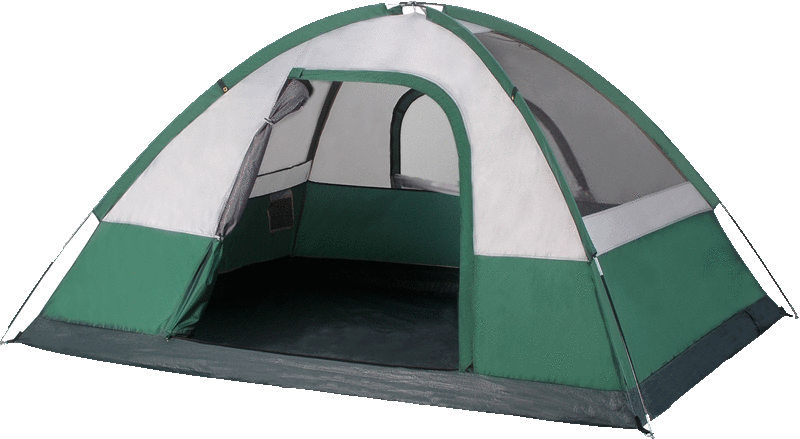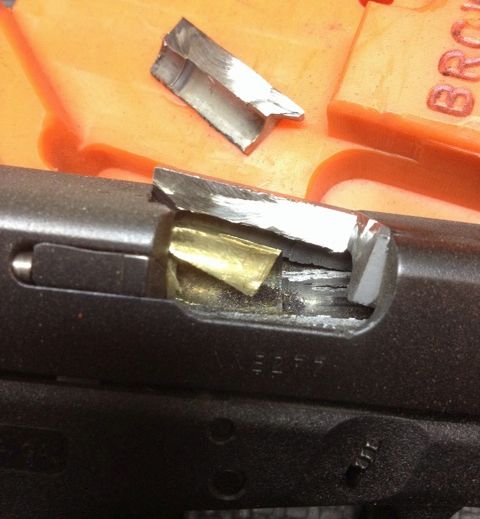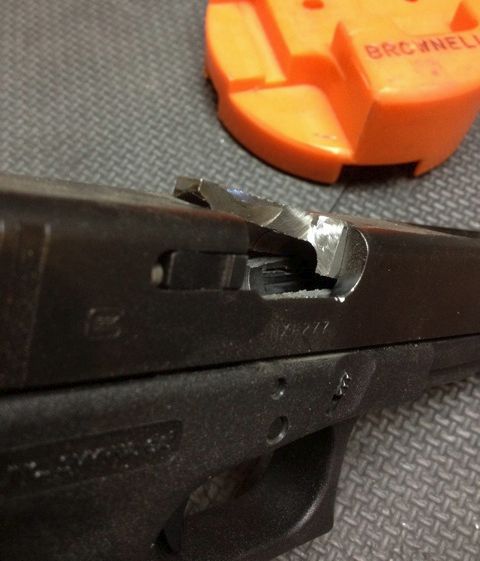If you reload your own ammo then you understand the satisfaction associated with
finding that perfect combination of bullet, powder, primer and case that will
deliver extreme accuracy in a particular gun. It is also, for some, a very
relaxing process where you can unwind from all the hustle and bustle of everyday
life.
But at times it also can be frustrating and get expensive especially to someone
who is a beginner. There is a lot, and I mean a lot, of information that has to
be learned and digested if it is to be done safely and accurately. Even long
time reloaders have to be always extremely attentive to what they are doing in
the reloading process.
I have been reloading ammo for various calibers for 15 or so years. I've read
tons of how-to magazine articles and entire books as well as reading reloading
threads online.
Before I go too much further, let me add that if you are interested in getting
into reloading or if you are a "seasoned reloader," never depend on someone
else's reloading data. Use the many reloading manuals available as your guide
in working up loads that you are going to use in your particular gun. If you
do choose to use an unpublished load formula from the internet or a friend or
even a magazine article, do so in a safe manner by starting off with lower
powder charges. What someone else uses in their gun may not be safe in yours.
So this brings me to why I am writing this article. Even a long time reloader
like myself is prone to mistakes. As I stated, I reload for several calibers
but want to talk about reloading for the .40 Smith and Wesson (S&W). Now this
is an extremely popular caliber today and used by many in competition shooting
and even law enforcement. It is a safe caliber to reload for as long as you
understand some things associated with this caliber.
I own and use a Glock 35 which is chambered for the .40 S&W caliber. Glock
pistols have a reputation for extreme reliability. This is what attracts me
to them. They are at the top of the list for self-defense pistols. But as
with many things, you have your loyalists for certain guns and that leads
people to either hate them or love them. I am of the latter group.
When I first decided to reload for my Glock 35, I had to go out and purchase
reloading dies. I use a Dillon 550B to load all of the handgun calibers as
well as a couple of rifle calibers. In my opinion, there is none better than
Dillon reloading equipment for reloading pistol calibers. Since the Dillon
company is located here outside of Phoenix, AZ in Scottsdale, I have the
luxury of going directly to their factory location.
When I told the clerk I needed some .40 S&W dies, he asked me if I was using
a stock Glock barrel or an aftermarket one. I told him I was using the
barrel that came with the gun. That's when he informed me of the problems
that the .40 S&W caliber Glocks were having if you were using brass that had
been fired from the factory barrels and once reloaded. They could cause
failure to chamber or even an explosion. He explained to me that the chamber
of the factory barrel did not fully support the whole length of the case when
fired and that it could cause small, sometimes unseen bulges down towards the
case head. This would cause difficulty in a reloaded round not chambering
properly.
So, in order to minimize this Glock .40 S&W anomaly, I decided to purchase an
aftermarket replacement barrel which offered full case support so that I could
avoid this problem. (RCBS now offers the G-RX Push-Thru .40 S&W sizing die
set which resizes the entire length of cases, thereby solving the bulge
problem due to factory Glock barrels and allowing the use of factory barrels
safely.)
So my reloading went well and I experienced no problems until one night last
year while participating in one of our club's practical pistol events. When
it was my turn to shoot the steel course of fire, on my third round I
experienced what many refer to as the "Glock Kaboom."
The breech end of my barrel had exploded and came up partially thru the slide's
ejection port. I felt a sting in my shooting hand and immediately froze.
While looking at the top of the slide and keeping the gun muzzle pointed
downrange, I surveyed the damage. Racing thru my mind was that I must have
had a reloaded round that did not get resized properly and that a bulged case
had caused this kaboom. Our shooting range official, Bill, who just happened to
also be timing me gave me the command to cease fire (not that I would have been
able to fire another round anyway) and to wait a minute before trying to clear
the gun or even inspect it.
After a minute or so, I pushed the magazine release button and the mag came out
with some additional pulling to assist it. I then proceeded to a designated
safe area. I was accompanied by Wade who is our club's Glock "guru." We could
visually see that the bullet had exited the barrel from the defective round.
But the barrel itself had split in two places halfway down its length and up
thru the slide ejection port with a shattered brass casing still stuck in the
barrel's breech end.
Let me add here that the sting I felt when this happened was not from any
shrapnel, but from the hot gas pressure of the blast itself. My hand was not
injured in any way, burned or cut. I was extremely lucky as this could have
been very disastrous. I also was wearing the proper eye and ear protection
which is mandatory for our club events as well as the range we were at.
In looking at the damage to my Glock, I thought it was completely trashed.
But after looking closer it seemed that the damage had been restricted to
the slide and barrel, not the lower. One big problem was that because the
breech end of the barrel was partially sticking up thru the slide ejection
port, I wasn't able to separate the slide from the lower.
The next day I took the gun to a local Glock armorer to see if they could
remove the slide from the lower. They tried, but couldn't. So when I
returned back home, I sat down on my work bench and stared at my poor Glock
for several minutes trying to think how I could get the slide and barrel off
and still save the lower (if it had even survived the explosion). I could
replace those two parts easily enough.
So I decided that I would get out my Dremel and start cutting the slide away
carefully piece by piece hoping not to do any damage to the lower. I started
cutting away at the exposed barrel portions first, still hoping to loosen the
slide up enough to get it separated from the exploded barrel. The brass case
came out easily using just a pair of needle nose pliers. Then I worked on
cutting out little pieces of the barrel carefully.
As I removed little pieces of the barrel, each time the slide would move a
little more. Finally with some more cutting, banging and punching, it broke
free. Much to my pleasure, the lower showed no damage. And to my further
joy, with careful hammering around the slide's ejection port I was able to
reshape it where it looked like a replacement barrel might work in it. I
still had the original factory Glock barrel for it, so I installed it in the
slide and it functioned perfectly.
A few days later, I was able to make a trip to the desert for a test firing
(using factory ammo). At first, I did slow firing. So far, so good. Next
I loaded up a 15 rounder and emptied it as quick as I could. 15 trigger
pulls, 15 rounds exited, and the slide locked back as normal when the mag
emptied. Was I lucky or what?
During this whole ordeal, I couldn't figure out the exact cause of what
actually made this happen. At first I thought that somehow the reloaded
case may have had a bulge but I ruled that out for two reasons. Firstly,
this is the only .40 S&W handgun I have and it had a better supported
aftermarket barrel installed so no bulges in cases should have occurred.
Second, I check each and every round I reload either in the barrel chamber
itself or with a case gauge. Did I miss one? Not likely, but possible I
suppose.
My belief is that during the reloading process I may have missed a split
case during my inspection of it. Or possibly somehow over charged the
powder load. I tend to not think the latter happened. I think a double
charge would have done much more damage to the gun as well as possibly
serious injury to me or others.
So, I guess the point of all this is that if you reload or plan to reload
sometime in the future, you need to be informed, vigilant, knowledgeable,
and careful. Do not be afraid or discouraged or even intimidated in
reloading ammunition. It can be enjoyable, rewarding and cost effective.
As a side note, this Glock 35 is now my designated home defense handgun.
Even though it has functioned flawlessly and safely, I have chosen to
replace the slide and barrel and practice with it using reloads. My
Glock now rocks safely again.

![]()




